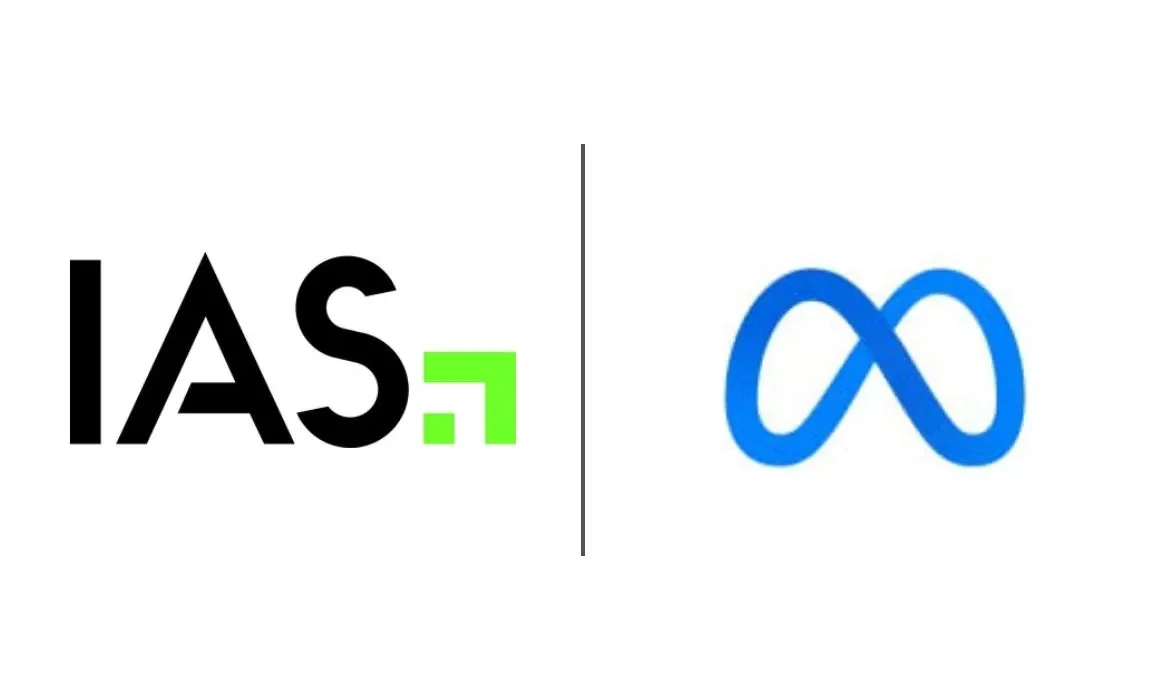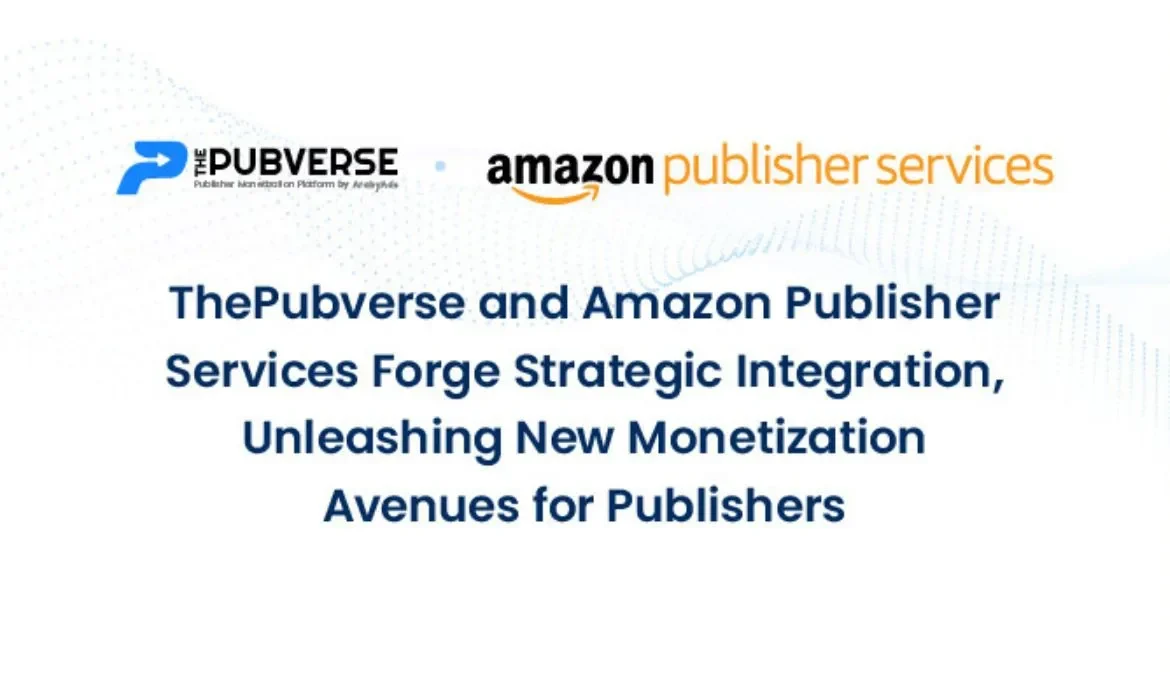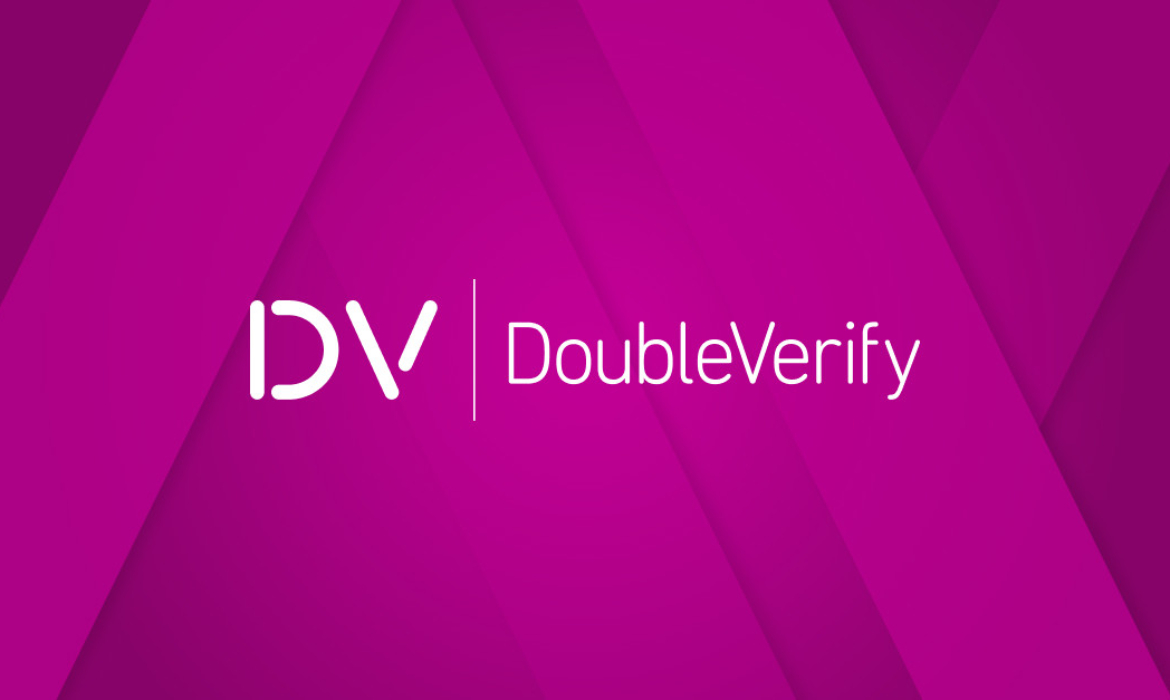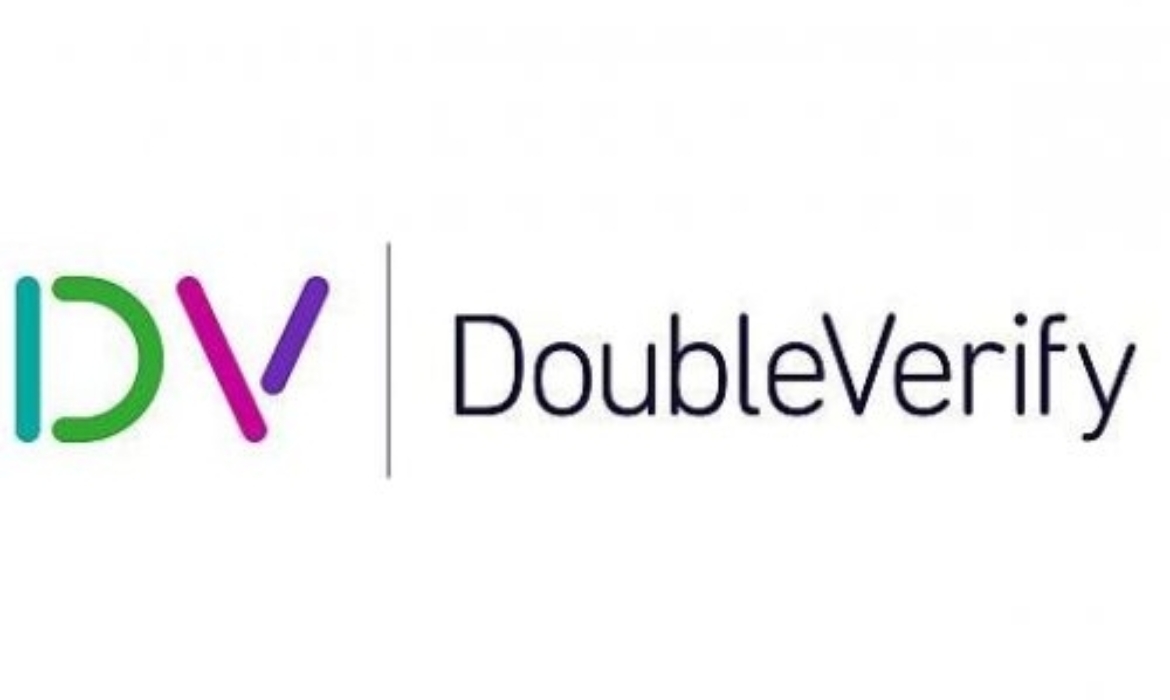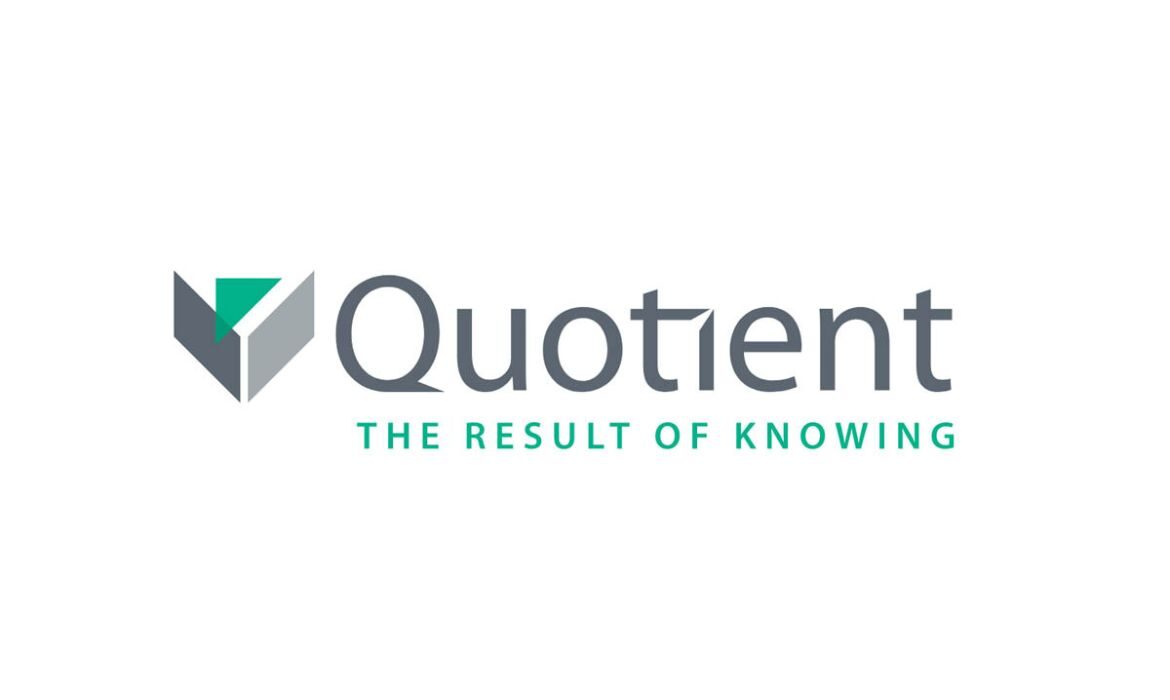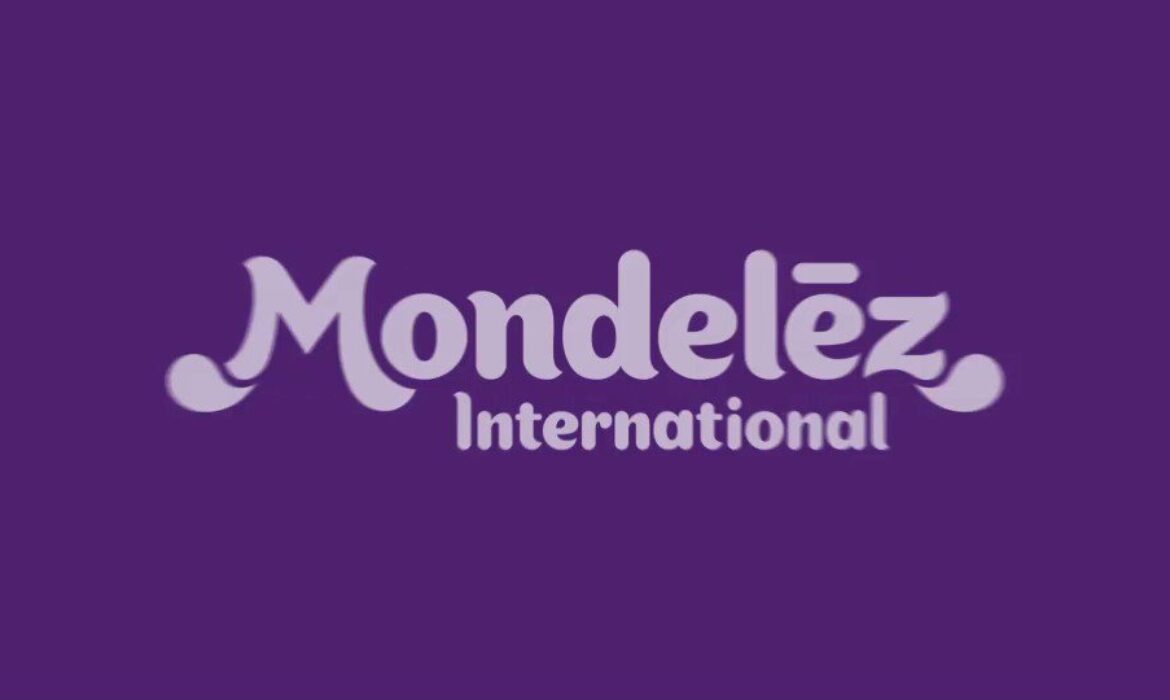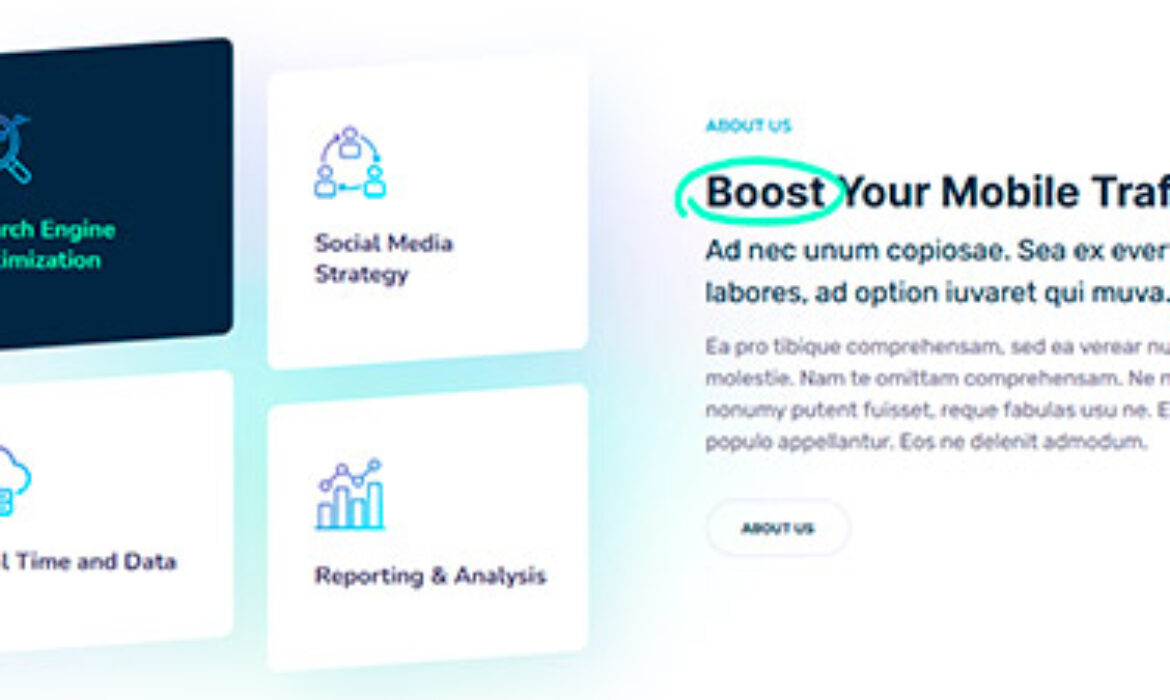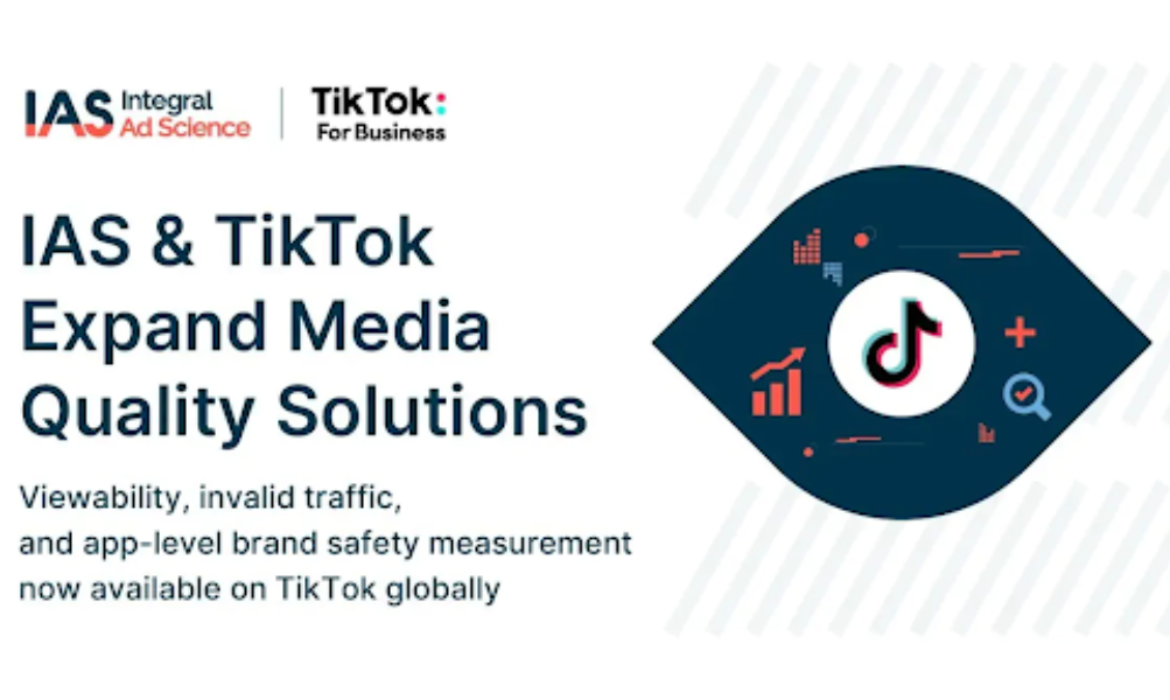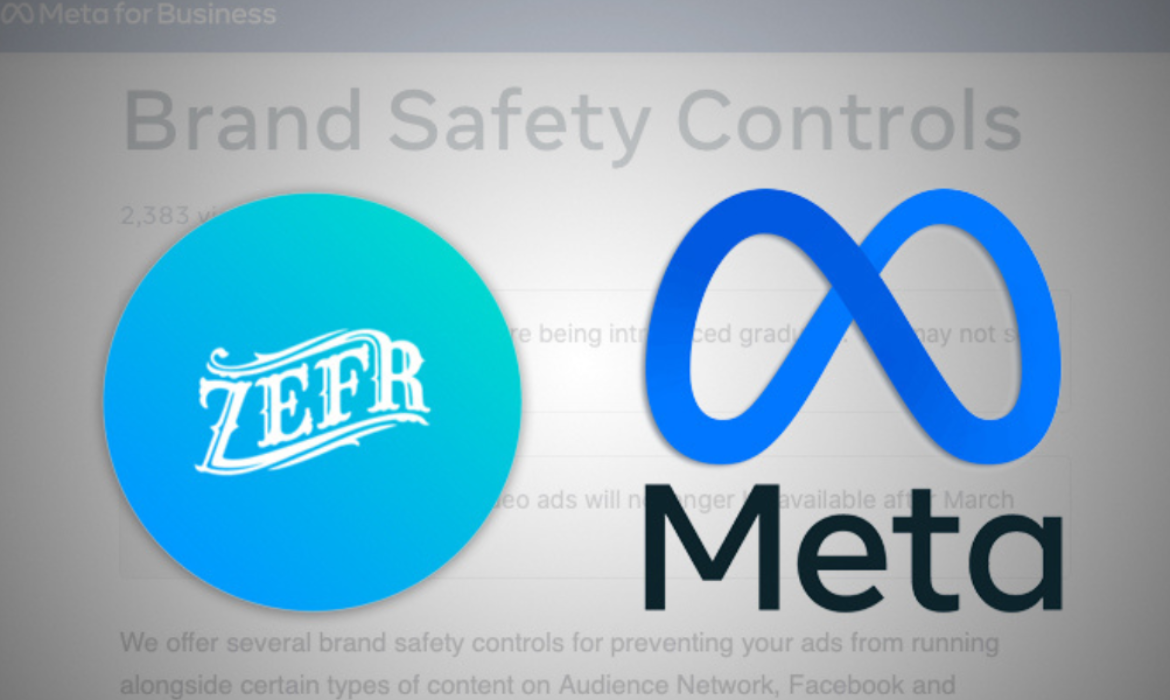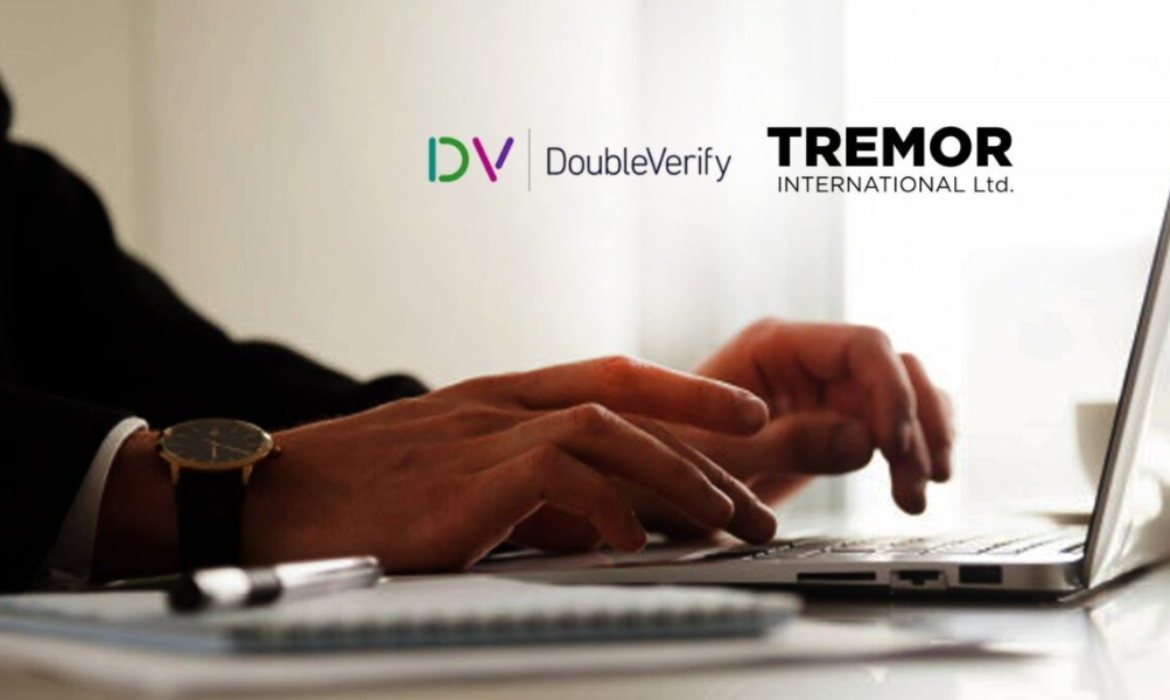IAS Announces AI-Powered Brand Safety and Suitability Expansion to Meta
Integral Ad Science, a leading global media measurement and optimization platform, has announced that its AI-powered Total Media Quality (TMQ) Brand Safety and Suitability Measurement product is now widely available on Facebook and Instagram Feeds and Reels. Advertisers may feel secure knowing that their media is showing up alongside content that is consistent with their brand’s objectives and values thanks to the availability of Brand Safety and Suitability Measurement for Meta on all Meta platforms.
IAS’s Brand Safety and Suitability Measurement
IAS’s collaboration with Meta to enhance post-bid brand safety and suitability measurement aims to give advertisers more information about where their campaigns are placed concerning appropriate and safe content. Advertisers have access to:
AI-powered categorization
IAS uses multimedia technology to measure posts that are close to an advertiser’s campaign. By analyzing images, audio, and text frame-by-frame, it can provide the most accurate measurement possible at scale. This allows for unique insights into video content.
Transparency and trust
With their transparent and reliable industry metrics, the measurement framework is in line with the Global Alliance for Responsible Media (GARM), giving advertisers third-party validation.
Third-Party verification
Marketers can assess how well their Meta Inventory Filters are serving their campaign objectives and make necessary optimizations.
Read More: DoubleVerify Includes YouTube Shorts in its Brand Safety Measurement Expansion
IAS and Meta partnership
IAS Signal is a unified reporting platform that advertisers can use to get the information and understanding they need to manage their digital campaigns with ease. The collaboration between IAS and Meta started in 2016 when IAS introduced Facebook viewability verification. IAS increased the scope of its viewability reporting and measurement in 2017 to include Instagram, Facebook, and the Facebook Audience Network. IAS began providing Facebook with its brand suitability offering in 2019. It added viewability and invalid traffic (IVT) measurement for Facebook and Instagram Reels to its measuring repertoire in 2023.
Here’s what they said
Lisa Utzschneider, CEO, IAS said,
IAS is steadfast in delivering solutions to help marketers measure and optimise performance in dynamic, user-generated social environments like Facebook and Instagram. This expansion allows brands to identify higher-quality media and scale across these platforms, signifying another important milestone in helping brands enhance brand equity across the entire digital ecosystem.
Samantha Stetson, Vice President Client Council and Industry Trades at Meta commented,
IAS’s release of Brand Safety and Suitability Measurement across Facebook and Instagram is a meaningful step forward in our continued work to provide transparency and trust across our advertising ecosystem. Responsible marketing is a top priority at Meta – and we are pleased with our continued partnership to bring this important solution to our advertisers.
Karyn Johnson, Vice President of Digital Marketing at Verizon added,
One of the most important things for us as an advertiser is maintaining the gold standard of brand suitability, and IAS plays a key role in protecting our advertisements from being placed in environments where it’s not safe or doesn’t align to our company values. It’s great to see IAS implementing this additional third-party measurement so we can use their tools to ensure we can reach those objectives across all platforms.
Read More: Vevo and Publica by IAS Announce Partnership for CTV Ad Serving
ThePubverse Announces Integration with Amazon Publisher Services
ThePubverse has announced its integration with Amazon Publisher Services. Thousands of publishers who make money with ThePubverse will be able to directly access high-quality demand from Amazon DSP and outside programmatic buyers thanks to this collaboration.
APS cloud infrastructure integration
Because of Amazon Publisher Services’ scalable, low-latency cloud infrastructure, publishers can now achieve increased revenue potential and maintain complete transparency, control, and brand safety.
Here’s what they said
Imad Sarrouf, CEO at ThePubverse, said,
We’re thrilled to be opening up new monetization opportunities to our publishing partners with this new integration. While ThePubverse already stands out with industry-leading Supply Path Optimisation (SPO) and Floor Price Optimization (FPO), thanks to the technology of Amazon Publisher Services. We’re able to further expand access to high-quality demand, bridging the gap for our publishers and Amazon DSP advertisers.
About ThePubverse
ThePubverse, an ArabyAds subsidiary, is a trailblazing publisher monetization company whose goal is to help publishers maximize their monetization strategies and establish connections with quality demand. ThePubverse provides efficient content monetization solutions to publishers of all sizes by utilizing cutting-edge technologies and specialized services.
Read More: Triton Digital Integrates Amazon Publisher Services for Interactive Audio Ads
DoubleVerify Includes YouTube Shorts in its Brand Safety Measurement Expansion
DoubleVerify (DV), a prominent software platform for data collection, analytics, and measurement of digital media, announced that YouTube Shorts will now be included in its YouTube brand safety and suitability measurement capabilities. With this expansion, brands will have more power to verify the suitability and safety of their campaigns on this expanding short-form video platform. Viewability and invalid traffic (IVT) measurements for YouTube Shorts are already available on both platforms. Advertisers can now measure and validate their campaigns across the entire ecosystem thanks to the extension of brand safety and suitability measurement to YouTube Shorts.
YouTube Shorts included in brand safety measurement expansion
With over 2 billion logged-in users each month, YouTube Shorts is a mobile-only video platform. It lets creators share brief, vertical videos with an audience. Marketers can increase the impact of their YouTube campaigns and engage their audiences with interactive, mobile-first creative builds by utilizing YouTube Shorts Ads. Advertisers will be able to measure and confirm campaign alignment with safe and appropriate YouTube Shorts videos with the release of expanded brand safety and suitability measurement. Additionally, the most recent features enable advertisers to obtain third-party confirmation that their campaigns are reaching the intended audiences through safe content.
Benefits of expansion
Reliable classification
To accurately classify YouTube Shorts videos across all GARM brand safety and suitability categories, additional DV suitability categories, and more than 40 supported languages, DV uses a combination of manual reviews and proprietary AI-driven tools.
Read More: DoubleVerify Unveils Industry-First Holistic MFA Protection Solution
Consistent settings and metrics
To help guide future media planning and purchasing decisions, advertisers can access industry-standard GARM-aligned brand safety and suitability settings. They can take advantage of the same degree of insights across various platforms and publishers.
Dependable measurement
By using an impartial third-party verification provider to verify the authenticity of their YouTube Shorts campaigns, advertisers can feel more confident.
Brand safety measures undertaken by DV
2011 saw the introduction of DV’s viewability and invalid traffic measurement services for Google and YouTube ad-serving platforms. DV joined Google as a measurement partner in 2018 for viewability and brand safety. Authentic Brand Suitability was introduced by DV on Google Display & Video 360 in 2020. DV achieved MRC accreditation in 2022, making it the first verification provider to do independent third-party viewability reporting on YouTube. DV introduced DV Campaign Automator™ earlier this year to optimize the Google Campaign Manager 360 trafficking workflow.
Here’s what they said
Mark Zagorski, CEO, DoubleVerify said,
Today’s announcement underscores our ongoing commitment to safeguarding brand equity and reputation across all media channels. Our innovative offering on YouTube Shorts provides YouTube advertisers with the tools they need to boost clarity and confidence in their media investment and verify brand-content alignment.
Read More: DoubleVerify Announces Expanded Measurement Coverage with S2S Integration
DoubleVerify Unveils Industry-First Holistic MFA Protection Solution
The renowned software platform for measuring digital media, DoubleVerify has recently extended its brand safety and sustainability offering. It attempts to make it possible for advertisers to track and get rid of MFA (Made for Advertising) websites. DV has advanced a precise definition of MFA with this breakthrough. Moreover, it helps marketers recognize and successfully handle MFA-driven challenges. To analyze MFA, DoubleVerify has unveiled its patented process that uniquely fuses human and artificial intelligence auditing. In their brand safety and suitability profile, customers may now easily enable DV’s solutions for measurement and monitoring. DV Authentic Brand Suitability will also be activated to avoid pre-bids.
Concerns about MFA websites
An ANA report was published in June amid worries that AI techniques were hastening the creation of offensive online content. It claimed that 21% (one-fifth) of all programmatic impressions were derived from MFA websites. Moreover, it attracted 15% of total ad expenditure. Additionally, DV carried out its independent investigation, wherein it was discovered that some MFA sites generate hundreds of millions of impressions each month.
Due to the lack of a standardized definition of what MFA is, it has led to misunderstandings. MFA content is often misconstrued as solely bot-driven and fraudulent traffic. But it only represents a small percentage of MFA traffic. Due to their false identities, these websites are excluded from standard fraud controls. On the other side, legitimate human users drive a majority of MFA traffic. They usually are directed to paid channels like social media and content recommendation engines.
Read More: Quotient Enhances DOOH Targeting with Brand Safety Capability
DV’s definition of MFA sites
According to DoubleVerify, MFA sites are the ones whose single purpose is to deliver ads. One can analyze several factors to locate these sites. The factors are set across ad monetization activities, ad traffic sources, and approaches to content creation. Particularly, these websites have the following characteristics.
- Significant ad density compared to the page’s actual content; frequent ad refreshes to optimize yield each visit.
- With hardly any traffic originating from organic sources, monetization is primarily dependent on paid traffic channels – for instance native and social.
- Constant scrolling and browsing through the same domain’s content
- Content that has been literally copied across several websites and is occasionally generated automatically by generative AI.
The approach that DV uses makes it possible to prevent false positives and miscategorization. It accomplishes this by enabling a thorough and complex level of testing. For instance, a website may have a sizable amount of ads while also receiving a lot of direct and search-enabled traffic. The publisher would not fit DV’s definition of an MFA website in this case. DV has mostly given its clients the capability to access MFA sites upon request. Beginning September 20, 2023, DV’s offering will be extended in beta to all advertisers. The solution will continue to change and advance over successive development cycles.
Here’s what they said
Mark Zagorski, CEO of DoubleVerify stated,
DV continues to lead with customer-driven innovation that helps advertisers tackle the rapidly evolving challenges in digital advertising that impact media quality and performance. With the rise of AI tools that can rapidly spawn MFA sites, DV’s own AI tech is crucial in empowering global brands to identify, measure and avoid problematic MFA content in real time and ultimately drive better marketing outcomes.
Jack Smith, CPO at DoubleVerify added,
The term ‘Made for Advertising’ has created significant confusion within the industry. As an industry-leading measurement and verification provider, we believe it’s crucial to lead by example and offer clarity. Our goal is to safeguard advertiser investments and support high-quality publishers who are seeking to monetize legitimate content.
Read More: DoubleVerify Acquires Scibids, Reinforces AI-Powered Solutions
Quotient Enhances DOOH Targeting with Brand Safety Capability
Quotient, a primary provider of digital promotions and media technologies has launched Brand Safety, a novel functionality within Quotient’s Digital Out-Of-Home (DOOH) platform. It empowers advertisers to successfully make sure their inventory is close to attractions, establishments, or companies that support their brand and message. With its unprecedented credibility and openness, this feature gives brands unrivalled power. It offers clients the reassurance that their DOOH adverts are displayed in secure and brand-safe settings. This development is able to dramatically increase the campaign’s efficacy by ensuring the integrity of its real-world promotions.
Quotient’s Brand Safety Feature
Historically, brands were hesitant to use DOOH advertising because it was difficult to implement well-known digital guidelines for campaign delivery and measurement. With Brand Safety from Quotient, brand marketers can design and execute highly targeted, successful DOOH campaigns. It can be used both independently and in conjunction with multichannel ad buys. This priceless feature increases not only the level of goodwill among brands and their customers but also the campaign’s overall effectiveness.
Read More: Double Verify Extends LinkedIn Partnership To Launch Brand Safety Hub
What’s in it for brands and advertisers?
DOOH advertising includes digital commercials. They are seen on display in public places like grocery stores, clinics, gyms, and pubs. It has become a really powerful medium. According to Quotient, DOOH advertising is highly viewable, contextually significant, brand-safe, and close to the point of sale. As a result, it has evolved into an indispensable channel for advertisers looking to attract their target markets. Displaying brand content in excellent settings that work well against brand objectives is crucial. With this new feature, advertisers will have more control over the placement of their DOOH ads across all inventory types. Additionally, it guarantees the caliber and applicability of advertising and successfully amplifies the brand’s message for the specified target market.
DOOH Landscape
Thanks to social media, out-of-home (OOH) advertising is on the rise once again. With billboards making up more than a third of all ad spending, it is still largely a traditional media. Digital formats are thus gaining popularity, such as in-office video panels and electronic displays. Recent years have seen a significant expansion of the DOOH market, especially in terms of developments in programmatic activation and assessment. Insider Intelligence projects that US DOOH advertising will account for 36.2% of OOH ad sales this year and over 41% by 2026.
Here’s what they said
Norm Chait, RVP of DOOH at Quotient stated in the press release:
We are thrilled to announce the launch of Brand Safety, yet another testament to Quotient’s expertise and unwavering commitment to providing innovative tools to ad buyers across the customer journey. With this valuable addition to our technology platform, we can now confidently reach consumers in brand-safe environments, which can lead to more impactful results for our valued clients.
Read More: Mondelez International Returns to X with brand safety committment
Mondelez international returns to X with brand safety committment
The first company to stop running advertisements on Twitter, now X which Elon Musk acquired, was Mondelez International, the company that makes the well-known Oreo cookies. Since then, X has been working nonstop for 9 months to provide an environment that is focused on creativity, exciting, and beneficial for advertisers. Thus, Mondelez made the decision to come back to the platform in May. The text-based platform strives to strike a balance between the right to free speech and platform security in order to entice brands to participate voluntarily in the debate.
The social media platform is extending its industry-leading collaborations and capabilities of Adjacency Controls to help all marketers achieve their unique sustainability needs in a more ascended and automated means. These new capabilities will work together to unlock an expanded level of adjacency protection for advertisers on X.
X has modified its brand safety features in response to worries about dwindling ad revenue. The platform is extending its current partnership with Integral Ad Science (IAS), an ad verification business, to provide US advertisers with “premium, vetted inventory.” Brands may now optimize their ads on X, and it wants to expand these solutions internationally. The platform is confident that these solutions will give marketers the assurance that their advertisements will run alongside relevant content and adhere to GARM standards.
Jon Halvorson, SVP of consumer experiences at Mondelez International, said in a statement,
X has made tremendous progress in building brand safety tools that empower advertisers to leverage the power of their platform while curating the context in which the ads appear. Adding pre-bid meets a critical commitment made by their leadership and we are eager to implement this new feature going forward.
WHY MONDELEZ PULLED OUT FROM TWITTER?
Mondelez International, the parent company for Cadbury and Milka chocolates had pulled out its ads from Twitter last year, just after Elon Musk had acquired. Reuters had reported that CEO Dirk Van de Put had said, “What we’ve seen recently since the change on Twitter has been announced, is the amount of hate speech increase significantly. We felt there is a risk our advertising would appear next to the wrong messages.”
The CEO made his comment as the acquisition phase was in a state of upheaval, with large layoffs and advertisers cutting back on spending prompting questions about content moderation. Apart from Mondelez, other businesses that have also removed their advertisements from the site included Audi, Pfizer, General Mills, and United Airlines.
Read More: Integral Ad Science Expands Brand Safety Partnership With TikTok
X’s BRAND SAFETY UPDATES
For a long time, advertisers had expressed worries about brand safety and content management on X. X created a pre-bid adjacency for marketers to overcome these problems. Since then, more than 1,900 international advertisers have tried the technology, which has a 99% efficacy rate for avoiding the proximity of dangerous information. Coca-Cola, Visa, Marriott, Mondelez, Taco Bell, Expedia, Amazon, and Applebee are a few of these brands.
Sensitivity Setting, a system that enables advertisers to coordinate their brand messaging with content was also introduced, according to X. The goal will be to bridge the delicate balance between accessibility and relevance and satisfy the brand’s sensitivity needs. Currently, the tool has two settings levels: Standard and Conservative. While the latter is for brands with rigorous sensitive limits, the former is for brands with a moderate sensitive threshold.
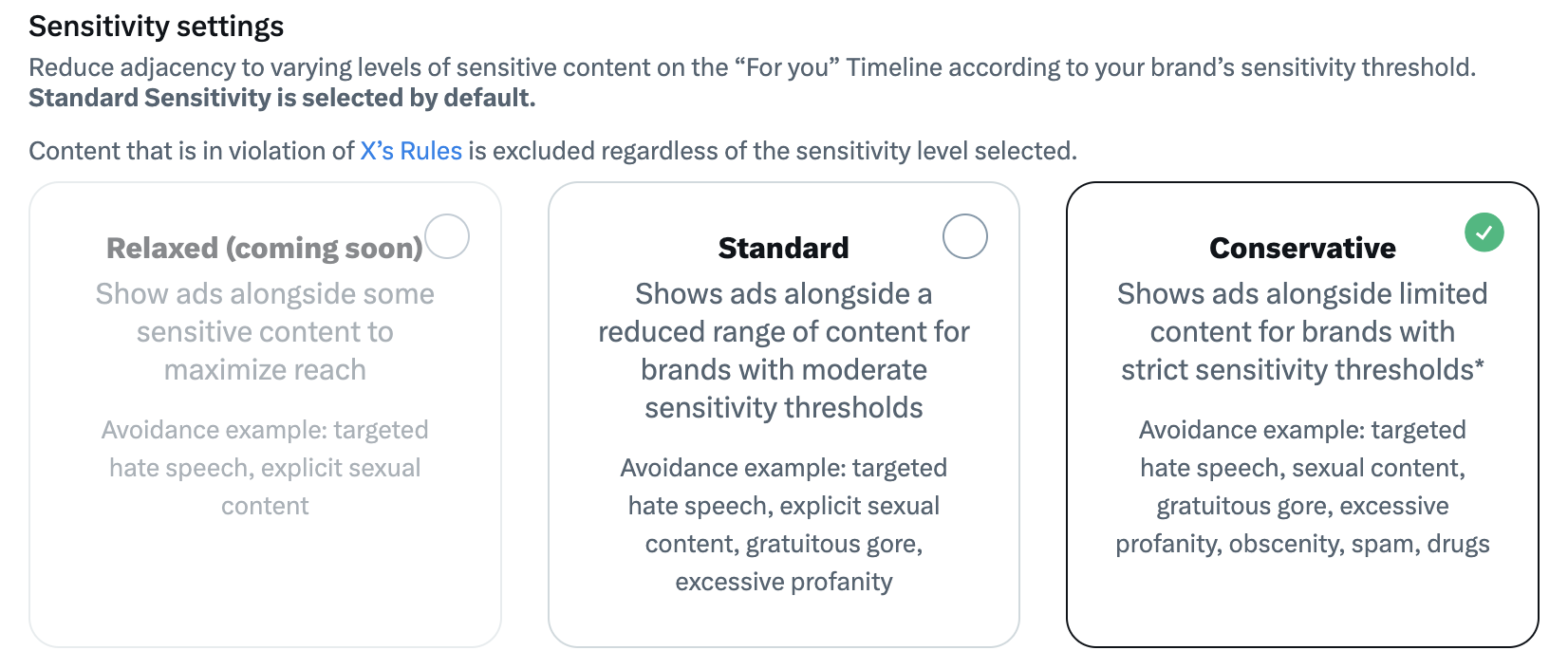
Image credit- X
For any campaign, Sensitivity Settings will use machine learning to modify the adjacency to various degrees of material in accordance with a brand’s sensitivity level. Brands are free to choose the setting they feel would best serve their unique campaign objectives. The automatic industry-standard blocklist that X is developing attempts to shield advertising from showing up next to dangerous phrases in the Home Timeline.
The platform has made significant strides in terms of brand safety and appropriateness because of X’s ongoing efforts to develop novel solutions. It pledges to give advertisers more power and accountability. It also claims to continuously construct new marketing capabilities. Its commitment to brand safety underlines the company’s dedication to fostering a responsible and secure advertising ecosystem, setting a positive precedent for industry standards.
Read more: Twitter Ad Revenues Plummet 59%, Record Negative Cash Flows
Double Verify Extends LinkedIn Partnership To Launch Brand Safety Hub
Double Verify, a leading software platform for digital media measurement, data, and analytics expands collaboration with LinkedIn to launch DV Custom Contextual and DV Authentic Brand Suitability on LinkedIn Audience Network. Together, they will provide mutual clients with scalable solutions to reach audiences, in contextually appropriate and relevant environments, at the right time – to help maximize campaign performance.
The two solutions empower advertisers to ensure their campaign impressions are delivered on inventory that aligns with their brand safety, suitability, and contextual needs. This DoubleVerify expansion is part of LinkedIn‘s plan to roll out a safety hub for its LinkedIn Audience Network. It also includes a list of publishers, as well as the ability to upload and apply block lists and custom-allow lists.

Credit: LinkedIn
How will the advertisers benefit?
DV Authentic Brand Suitability goes beyond standard categories and keyword blocklists and offers customized protection to advertisers to avoid unsafe and unsuitable content before placing a bid. DV Custom Contextual provides advertisers with a scalable solution to reach the right audiences, at the right time – driving outcomes for brands.

Credit: LinkedIn
As part of this release, the company builds on its previous work with LinkedIn to provide brand safety floors and invalid traffic protections on LinkedIn Audience Network. It ensures advertisers are protected from universally unsafe content. Through the Brand Safety Hub, LinkedIn aims to help marketers boost their advertising campaigns on the LinkedIn Audience Network, while also allowing them to customize their brand safety guidelines.
And what they said
Steven Woolway, EVP, Business Development at DoubleVerify said,
“Our work with LinkedIn underscores DV’s continued leadership position in optimizing media quality and performance holistically across the digital media landscape providing our advertisers the confidence to invest across channels and environments.”
“LinkedIn is a leading platform for B2B digital advertising, and we are thrilled to collaborate to support brand suitability and contextual targeting.”
Adweek reported that LinkedIn vice president of product Abhishek Shrivastava said in a statement,
“Through our work with DoubleVerify, we’re continuing to empower our customers to scale their marketing across our network of publishers to reach and engage a professional audience. The evolution of our collaboration reinforces our goal to foster a safe and trusted ecosystem with added controls to help customers drive better value from their campaigns.”
Read More: The Journey From Deterministic To Probabilistic Marketing
Integral Ad Science Expands Brand Safety Partnership With TikTok
Integral Ad Science and TikTok, a global leader in digital media quality, has expanded their existing partnership with TikTok. In addition to the IAS, Brand Safety Solution launched last September, IAS will now be able to measure viewability, invalid traffic (IVT), and app-level brand safety, allowing brands and agencies globally to effectively monitor the quality of their media buys on TikTok’s platform.
The company said advertisers will now be able to verify the performance of their TikTok campaigns, with trusted third-party measurement powered by the Open Measurement Software Development Kit (OM SDK). The OM SDK is governed by IAB and designed to facilitate transparent third-party viewability and verification measurement for ads served to mobile apps and open web environments.
Additionally, IAS will provide advertisers with granular campaign performance reporting 24 x 7 via its ‘Signal UI’, which will assist them to take immediate action and remain informed on campaign performance in real-time. Third-party verification is key to ensuring advertisers are getting the most out of their campaigns. This facilitates planning, KPIs, and measurement.
Interesting Read: The New World Of TikTok Marketing, Everything You Need To Know!
And That’s What They Said
Lisa Utzschneider, CEO, IAS said,
“We are excited to offer marketers an increasingly comprehensive set of IAS Media Quality Solutions to manage their advertising campaigns on TikTok. It is more important than ever for marketers to engage with users on social platforms and ensure that their ads appear next to brand safe & suitable content on a global scale. We are thrilled to deliver a holistic solution on TikTok and provide new levels of transparency and precision for these campaigns.”
Melissa Yang, Head of Ecosystem Partnerships, TikTok added,
“We’re thrilled to build on our partnership with IAS and introduce new solutions that give brands the confidence to scale their businesses and audiences on TikTok. Through this expansion, brands and advertisers around the world will have access to IAS viewability and invalid traffic measurement tools to monitor the quality of their campaigns on our platform. We’re excited to see how this will usher in new levels of transparency and success for our clients.”
Interesting Read: 6 Data Privacy Trends To Look Out For In 2022!
Meta Taps Zefr For Brand Suitability And Improve Advertising Safety Tools
Meta partners with brand suitability provider Zefr to enable advertisers to ensure that their promotions don’t appear alongside potentially offensive material on the Facebook Feed. It will provide more options for brands to manage their ad placements across their apps.
Why Zefr?
Meta stated in their blog that after an extensive vetting process, they collaborated with Zefr together to develop a solution to measure and verify the suitability of adjacent content to ads in Feed, with the goal of starting with small-scale testing in the third quarter of this year and moving to limited availability in the fourth quarter. Rich Raddon, co-founder and co-CEO of Zefr said in a statement,
“The future of the ad industry is moving towards transparent and accurate measurement for brand safety and suitability in complex environments, based on the GARM standards. Zefr is thrilled to partner with Meta to develop the first suitability measurement product for Feed, giving advertisers deeper transparency into their content adjacencies across Meta.”
Additionally, Zefr has also collaborated with TikTok and YouTube on similar initiatives, leveraging advanced AI systems along with human reviews to provide customized brand safety solutions and more control to ad partners.
Interesting Read:A Look Ahead: Convergence Of Linear TV And Digital TV Advertising
How will it benefit the advertisers?
The main aim is to give Meta advertisers a better understanding of the types of content that appear adjacent to their ads, helping them make informed decisions to reach their marketing goals. As the integration with Zefr reaches limited availability, Meta will work toward having the brand suitability integration opportunity open to all badged partners.
The move is part of Meta’s answer to longstanding demands from the advertising industry, which has advocated for brands to be given greater control over where their ads appear online. Advertisers have demanded tools to help them customize and prevent ads from appearing adjacent to content the brand deems unsuitable, such as politics or news about death or violence.
Meta has also been working closely with GARM as it develops these controls, which will be aligned with the GARM Suitability Framework. Rob Rakowitz, GARM Initiative Lead, World Federation of Advertisers welcomed the partnership saying it will provide the advertisers the much-needed post-campaign transparency which is difficult to measure sometime.
“In our quest to eliminate harmful content from ad-supported digital media, we need controls on where ads appear and measurement to verify the accuracy of those placements.”
Interesting Read: AdTech Vs MarTech: Let’s Settle This Once For All!
The social media giant has started to build controls for the Facebook and Instagram feeds primarily for English-speaking markets first. Next year, the company plans to expand the placement coverage to include other languages, Stories, Reels, Video Feeds, Instagram Explore, and other surfaces across Facebook and Instagram. Meta vice president, client council, and industry trade relations Samantha Stetson said,
“Providing advertisers control over the content their ads appear next to is incredibly important work for us, and to our commitment to the industry via GARM. We’re excited with the progress we are making toward building content- based controls for Feed and are excited to start development with Zefr on third-party Feed verification. It will take time, but it’s the right work to do.”
Interesting Read: Is Microsoft Reinventing Its Ad Business With Massive Acquisitions?
Tremor International Partners With Double Verify For Authentic Brand Suitability
Tremor International expands its partnership with Double Verify (DV), a leading software platform for digital measurement, data, and analytics for Authentic Brand Suitability Solution. Tremor is a leader in video and Connected TV (“CTV”) advertising. The company offers advertisers and publishers a comprehensive technology platform that combines Tremor Video and Unruly SSPs to reach relevant audiences and maximize the yield on digital advertising inventory.
How Does Authentic Brand Suitability Help?
Tremor International (Tremor) aims to provide the most robust programmatic brand safety solutions in the market. Authentic Brand Suitability helps to achieve this objective by offering advanced brand safety, suitability, and fraud solutions to support advertiser campaign performance across devices, including CTV.
Tremor Video and Unruly’s advertising clients can leverage this pre-bid targeting solution to implement centralized brand safety/suitability and fraud controls across all campaigns and devices. Further, advertisers within the platform will now have access to enhanced security levels, leading to increased operating efficiency and improved campaign performance.
Interesting Read: Taboola And Double Verify Partners For Brand Safety
Steven Woolway, EVP of Business Development at DoubleVerify said,
“Driving better advertiser outcomes, whether across CTV, desktop or mobile video, starts with ensuring that inventory is optimized per the marketer’s specific suitability demands.”
He further commented.
“Authentic Brand Suitability helps accomplish this objective, by offering the most advanced brand safety, suitability, and fraud solution available in the market today. DV’s enhanced integration with Tremor International reinforces our commitment to help advertisers ensure the protection of their brand equity, wherever and however they buy digital media.”
Interesting Read: Connected TV Explained: The Essential Glossary Of CTV
Key Benefits Of Authentic Brand Suitability
In the past, advertisers have used adblocking but that only protected advertisers from having their ads appear in unsuitable environments, and however, nonetheless, this incurs costs.
Authentic Brand Suitability drives better advertiser outcomes and this is how it does,
- The alignment of pre-and post-bid settings drastically reduces the wasted cost of media through the avoidance of pre-bid scenarios.
- DV data suggest a 26% lower block rate for programmatic media properties supporting Authentic Brand Suitability, which safeguards their brand equity from safety and suitability violations.
Other significant benefits for the Tremor and Unruly advertising clients include:
Customizable Controls: A complete set of customization options enable users to build a single targeting profile that combines 90+ brand safety and suitability categories (the broadest available), keyword avoidances, language avoidances, site/app IVT threshold avoidances, and custom-built brand categories.
Operational Efficiency: Using the industry’s first unified service and analytics reporting platform, DV PinnacleR, to ensure consistent, automatic updates to post-bid measurement settings and pre-bid targeting across numerous DSPs.
In this announcement, DV and Tremor International are expanding on their existing partnership. Recently, Tremor Video and Unruly were awarded DV’s CTV Targeting Certification, demonstrating their ability to avoid fraud on CTV devices with DV’s pre-bid app.
Jessica La Rosa, Vice President, Partnerships & Data Operations at Tremor International said,
“As long-time leaders in the video space, we pride ourselves on the ability to empower our clients with innovative solutions, helping them maximize the effectiveness of their advertising initiatives.”
Interesting Read: DoubleVerify MRC Accreditation: How Can CTV Advertisers Benefit?

